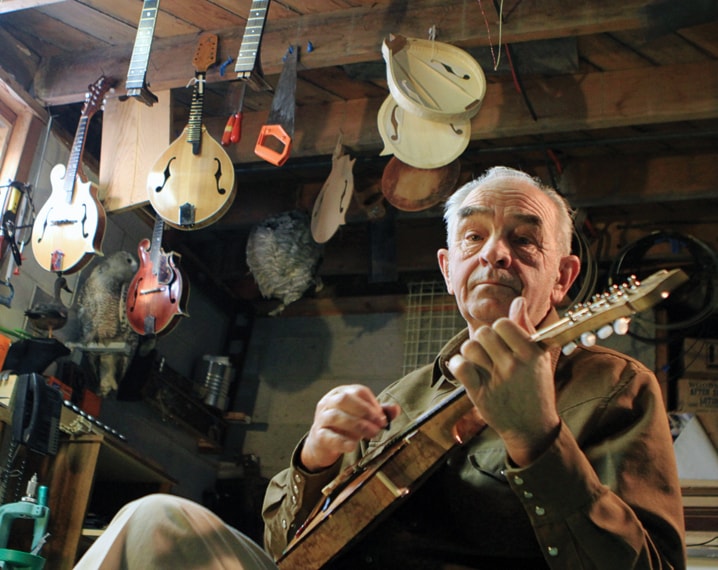Pulling a small plank from a stack in his basement workshop, mandolin maker Orla Nielsen gives it a tap.
The warm “ring” that emerges from that small piece of Engelmann spruce cut from high in the mountains coaxes out a smile.
“That’s a good sign. You’re going to take your chance on that one.”
There are no sure bets in mandolin making, says Nielsen, 71 who has been crafting exquisite instruments in his small basement workshop in his home 10 km west of Markerville for the past 11 years.
It began as a retirement project after a career ended as a gas plant and field operator. A lifelong guitar player and repairer, he was determined that when he had the time he would raise the ante and try to build an F-style mandolin.
“I thought I might as well make the toughest of the mandolins to start with — and if it turns out I’ll make some more.”
Nielsen’s foray into making mandolins hit all the right notes from the get-go. He ranks his very first effort as one of his best — and that’s 23 mandolins later.
That first one was born out of scrap wood rescued from discarded pallets at an Alix gas plant.
Despite it’s humble origins, it produces a sound as warm and pure as any as he plucks out Bonaparte’s March.
“The first one turned out great,” he says.
“The second one didn’t turn out very good at all. And the sixth turned out terrible. But the rest have all been in the ballpark.”
While his guitar repairing background proved useful, there was still much to learn when it came to mandolins.
“The first thing you learn is to sharpen your tools,” he says. “Because there’s a lot of carving in these.”
It’s a hobby where fractions of an inch loom large.
The centres of the sound board must be a quarter-inch thick in the centre and one-eighth on the edges.
To be sure of his measurements, he built his own set of calipers.
On his latest project, a hole was drilled one-thirty-second of an inch off its mark.
“That means he’s got to plug it and redo it.
There are reference books that helped in the beginning — but not much. The craftsman must develop a feel for each piece of wood, Nielsen explains.
“One is thicker than another. One is heavier. You have to make judgments on all this.
“If you’re right, you’re happy. And if you’re wrong — that’s the way she goes,” he adds, with a shrug.
When the top board is shaped, a tap should yield a G note. “If you’re in the G, you’re in the ballpark for a good-sounding instrument — hopefully.
“And I have had some wrecks, believe me,” he says with a laugh.
Nielsen doesn’t count the hours that go into converting pieces of wood into an instrument that has drawn praise from professional mandolin players like award-winning American blue grass musician Rhonda Lea Vincent, who has borrowed his creations to play in concert more than once.
“Three hundred (hours) maximum. Two hundred and fifty minimum.
“This is all guess work. Believe me, I don’t know. I’ve never put a clock on myself.
“But to get two done in a winter, I’m down here quite a bit.”
Nielsen’s masterworks sell — when he does sell them — go for $3,500 and up. He’s also repaired about 20.
But money is not why he makes mandolins.
He’s done a handful of commissions and has already decided never again. “You feel like somebody is waiting and I’ve got to work on it. I’ll not do that anymore.”
Now, he does them in his own time. Once they’re finished, and the instrument is given time to loosen up and provide that warm, full sound mandolin players love, then he’ll consider offers.
Word of mouth brings the musicians to his door.
What is it that keeps him at a hobby that requires such painstaking commitment?
“I like the outcome,” he says. “I’m always waiting for this,” he adds, pointing to his latest project nearing completion on his workbench.
Nielsen waves off any suggestion that he’s aiming for a certain number of completed instruments.
“Heavens no! The only thing I ever did was try every stinkin’ piece of wood you could find just to see what each does. I’ve done damn near all of them now.”
If there is a goal, it is the search for that elusive instrument that surpasses all others.
“You’re looking for that one that comes out and does it all,” he says.
“This one here is not far from it,” Nielsen says, pointing to his 19th mandolin.
“It’s very close to about as good as you’re going to get them.”
But Number 24 is almost done. Maybe that’s the one.
Or will it be Number 25?
pcowley@www.reddeeradvocate.com
